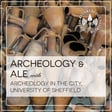
Half Pint: Roots and Future with Lizzy Craig-Atkins - Ep 34
Archaeology and Ale is a monthly series of talks presented by Archaeology in the City, part of the University of Sheffield Archaeology Department’s outreach programme. Half Pint is a short interview-style format which we will be undertaking during the COVID-19 lockdown. In this first Half Pint interview, we welcome Dr Lizzy Craig-Atkins speaking about the Roots and Futures project.
Lizzy is a senior lecturer at the University of Sheffield's Department of Archaeology. Her work focuses on human osteology and paleopathology with an interest in multidisciplinary approaches to past population structures, health, disease and lifestyle. Currently, Lizzy is involved in the Roots and Futures project which aims to involve members of the community in creating new understandings of Sheffield’s built and buried heritage. For more information on Lizzy and on Roots and Futures please follow the links below.
For more information about Archaeology in the City’s events and opportunities to get involved, please email archaeologyinthecity@sheffield.ac.uk or visit our website at archinthecity.wordpress.com. You can also find us on Twitter (@archinthecity), Instagram (@archaeointhecity), or Facebook (@archinthecity)
Affiliates
